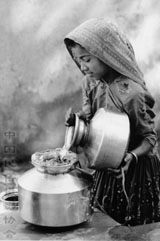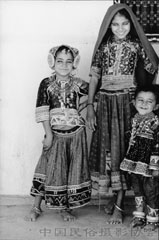|
|
| |
|
|
| |
|
|
|
|
|
| HISTORY |
|
| Indian
civilisation is more than 5000 years old and is the largest democracy
in the world. It is the seventh largest country of the world
and the second most populated (over 1 billion). It is about 1/3
the size of the United States. |
| India
has the Himalayan Mountains to the north, the Arabian Sea to
the west, the Bay of Bengal to the east and the Indian Ocean
to the south. Pakistan is on its western border, Bangladesh and
Myanmar (Burma) on its eastern border and Tibet and China on
its northern border. Sri Lanka is the island off India's southern
tip. |
|
| India's
capital city is New Delhi. The country's population is made up of 72%
Indo-Aryan, 25% Dravidian and 3% Mongolian. All five major racial types
are represented in India (Australoid, Mongoloid, Europoid, Caucasoid and
Negroid), making India a country with probably the largest and most diverse
mix of races. At various periods of India's long history, successive waves
of settlers and invaders including the Aryans, Parthians, Greeks and Central
Asians, Jews and Zoroastrians came into the country and merged with the
local population. This explains the variety of racial types, cultures
and Languages in India. |
| India's
main languages are Hindi and English, plus 15 other main languages and
over 700 dialects. India's religious diversity consists of 82% Hindus,
11% Muslims, 2% Christians, 2% Sikh, 0.7% Buddhist and 0.7% Jains. |
| India's
first major civilisation flourished for a thousand years from around 2500
BC along the Indus River valley. Its great ancient cities were Mohenjodaro
and Harappa (now in Pakistan) where an advanced urban civilisation flourished.
Lord Shiva, a great god and important symbol of Hinduism, is thought to
have originated from this culture. |
| In 1500
and 2000 B.C, Aryan invaders from central Asia invaded and secured control
of northern India and pushed the original Dravidian inhabitants south.
The Aryan rule was interrupted shortly in 327 BC when Alexander the Great
attacked the Indus River region and captured large areas of North India
and ruled till his death in 323 BC. The Aryan rule continued and its Gupta
Empire was the most glorious with its peace and prosperity and is considered
as "The Golden Age" in Indian history. |
|
In
1192, the Delhi Sultanate became India's first Muslim kingdom.
1526 saw the
start of the Mogul empire. The Mogul emperors are the giants of
Indian history and of Muslim rule in India. The Moguls combined
Hindi and Arabic languages to give rise to a new language Urdu,
and generally ushered another golden age of building, arts and
literature. Nowhere more is the grandeur of Mogul architecture
displayed than the most visited monument in India, the Taj Mahal.
Mogul ruler Shah Jahan built the Taj Mahal as a mausoleum for his
beloved wife Mumtaz.British
rule in India was initially exercised by the East India Company, which
established a trading post at Surat in Gujarat (Western India)
in 1612.
The British were not the first or the only European power with a presence
in India in the 17th century but they soon established their dominance
over India, which lasted about 200 years. Opposition to British
rule began
in earnest at the turn of the 20th century. |
|
| Mahatma
Gandhi, a humble attorney, returned from South Africa to his motherland
to question British rule and insisted on India's freedom while adopting
a policy of passive resistance, or satyagraha in Hindi. At the same time
WWII dealt a blow to colonialism and Indian independence became inevitable.
|
| Within
India, however, the large Muslim minority resented the impending majority
Hindu rule and tensions began to mount between the two. Faced with a political
standoff and rising tension, the viceroy, Lord Louis Mountbatten, reluctantly
decided to divide the country and set a rapid timetable for independence.
When the dividing line was announced, a great exodus took place as Muslims
moved to Pakistan and Hindus and Sikhs relocated to India. The effects
of that move are still felt in India and Pakistan today. |
| India
became independent in August 1947. Pandit Jawaharlal Nehru became the
first Prime minister of independent India, and Dr. Rajinder Prashad was
nominated as the first President of the Indian republic. |

